Why Do We Only Care About Two Parties?

If you have been following the presidential election lately you might have found yourself in one of two camps. You might have found yourself either becoming frustrated with both candidates and you have decided to vote for a third party candidate; or, you might have found yourself being so frustrated with the system (or the candidates in general) that you don’t think you’ll be voting at all. In either case, this common frustration has left many to wonder – why do we only care about two parties?
Admittedly it does seem a bit anti-democratic to have only two pragmatic options for the “Leader of the Free World.” After all, in other countries there are many political parties, in Germany and Turkey for example. So why does the United States of America have such a straitjacket in their election process? Well, it’s complicated.
In the scientific cannon, very rarely do you establish something called a “law.” A scientific law is something that is has been proven (beyond doubt) to be a causal relationship to better explain the world around us – Newton’s Law of Gravity is an example. Well, as it turns out political science really only has one law (with admittedly some error) and that is one that describes the origins of political parties – Duverger’s Law.
Duverger’s law posits that when a nation has a particular type of election process, political parties will form to be most beneficial to winning that type of election. For example, in Germany and Turkey there are proportional elections where voters select a party that they like and if that group is selected and gets beyond a certain election threshold (say Turkey’s 10% threshold) the party gets a percentage of representation in government. In contrast, the United States has what’s called “First Past the Post” (FPTP) elections where the candidate with 50 +1% of the representatives win the office. This is broken down to each elected office throughout the nation. So what we end up seeing is multiple parties representing the electorate in other countries whereas, in a strategy to win, the United States really only has two main competitors.
Of course there are many third parties, just like there are thousands of presidential candidates, but we narrow it down to only the top competitors before and during the primaries. Many people dislike such restrictions that seem to undermine the well needed nuance and multidimensional framework needed to tackle complex issues of the day. In fact, according to Gallup data from 2003 to 2015 many would support the idea of a third major U.S. political party – even many those aligned with one of the major two parties.
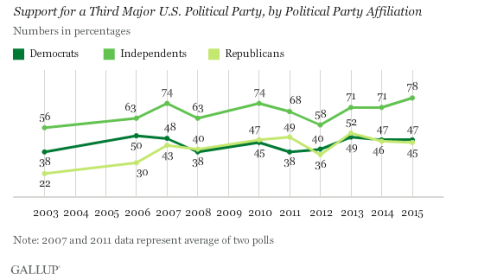
Arguably, the political climate is ripe for such an emergence of an “outsider party.” Yet, it seems as if the American electorate was more comfortable trying to bring in “outsider candidates” into their existing party framework.
There’s much more to be said on this topic (I’ve recommended some books at the bottom of this article) but essentially whether it be elite manipulation, media influences, party power, lobbying, gerrymandering, or political polarization – it is looking as if the two party system is here to stay. But it’s not all that bad.
Political parties offer candidates the resources and support network to become noticed. Political parties also provide the electorate with a surprisingly accurate heuristic for voting. Also no two candidates in a party are the same, so there is a lot of variation within our simplistic party system – just ask any Republican not voting for Trump. Finally, much of the geographical space in America is contested creating “purple” zones of populations that are diverse in representation. For example the visualization of the data received from the 2008 Cooperative Congressional Election Study (CCES) shows that much of America is independent or more “purple” in their political preferences.

What voters are challenged to do is either vote pragmatically or with their ideology. Voting pragmatically means to scale up either candidate and choose the candidate that they feel is better than the other. Voting ideologically is to vote for any candidate on the individual’s principles.
While voting for a third party may seem like “throwing your vote away” in terms of data and political representation it is anything but that. Even voting Republican or Democrat in the hardest of opposite-colored states it is still good practice to vote, it tells our politicians that their area of representation is far more purple than they think. It also tells our representatives that you’re an active voter and an advocate if you dislike something they’re doing. The real case of “throwing your vote away” is when you don’t vote, because then you are giving the message that you don’t care or don’t wish to be acknowledged when it comes time to think about policy implementation.
So whether you vote Democrat or Republican, Green or Libertarian, Tea Party or for any of the many national Socialist parties across the nation, take solace in the fact that the two party system has some up sides. If you are still frustrated, well then you are not alone. As it turns out nations with a FPTP election system have abysmally small voter turnout when compared to similar nations with multi-party systems.
The main book I would recommend for further review on this topic (as it deserves) would be John Aldrich’s “Why Parties?” but also D. Ray (1967) and Easton have both been cited thousands of times for their commentary on the formulation of two party systems.
Image credit goes to “IntelligenceSquared” an organization which promotes constant debates and exchanges in ideas even beyond politics. I am a regular to their website: http://www.intelligencesquaredus.org/
How to Fill a Supreme Court Seat: A Guide for Senate Republicans
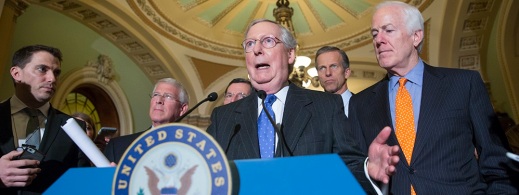
In early February Senator Mitch McConnell (R-KY) threatened to block President Obama’s Supreme Court nomination until after the new president took office saying,
The American people should have a voice in the selection of their next Supreme Court Justice. Therefore, this vacancy should not be filled until we have a new president.
Since, many republicans have joined McConnell’s “movement” even forming pro forma sessions with no particular agenda to specifically dodge a meeting with the president so that it impedes the progress on filling Scalia’s old seat (more on this process later).
Given this purposeful gridlock from the GOP, I thought it might be useful to put together a guide for senate republicans on the arguments against what they are doing and how to eventually fill the vacant Supreme Court seat, like the Constitution requires.

As we can see, most of the time throughout history nominees are accepted without a hitch. The two primary factors that disrupt a nominees success are their political ideology and qualifications. The run-of-the-mill strategy for presidents currently is to select a centrist candidate with unquestionable qualifications. Most of the cases in which we see a rejection of a candidate has been because of these two areas. Yet, even ultra liberals like Ruth Bader Ginsburg passed with a 96-3 vote and ultra conservatives like Scalia passed unanimously 98-0. So qualifications matter.
So who does Obama want to put up on the Supreme Court? Obama has selected Judge Merrick Garland who has a Harvard law degree, has worked in the Supreme Court before, aided in the prosecution of the Unabomber, and is the current incumbent Chief Judge of the United States Court of Appeals for the District of Columbia Circuit. Qualifications? Check. As for ideology, Garland has been considered by many to be a centrist/liberal candidate. Ideology? Check.
Yet, we know that is not about past nominees or about the candidates likelihood of passing in itself, for republicans it is largely about Obama putting someone up for nomination on an election year.
This specific point generated the following claim from Mike Honda (D-CA)
Six justices [on the U.S. Supreme Court have been] confirmed in presidential election years since 1912.
Politifact researched this and gave it a “True” rating, going even further to note that five of these election-year nominees were actually confirmed by the Senate – shown below.
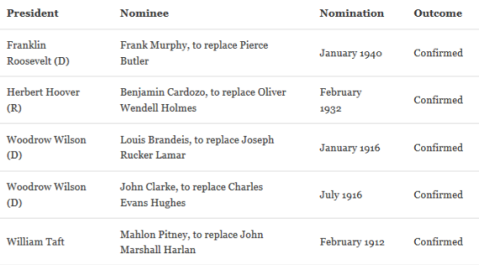
I think a final point to be made is the irony of preaching the Constitution to Republicans. Republicans often tout their sincerity and divine love for the Founding Fathers and the Constitution yet appear to have an affair when it comes to Obama doing his Constitutional duty listed in Article II, section 2.2.
So overall, Obama is merely following the historical precedent of putting up a nominee that is moderate and well qualified, the Senate in the past has typically approved these candidates – even on election years multiple times. If Republicans truly want to tout the Constitution, then they should at least consider Obama’s nominee.
Moving forward, what does this process look like? The Washington Post put together a pretty accurate info-graphic that explains the process pretty well:

So Obama’s nomination (eventual nomination that is) would be followed by an initial filter, followed by some initial hearings from the Senators and President (but have been stifled by the make-believe meetings Senators have arranged for themselves). There would then be a committee vote; if passed, the President would leave the process up to the Senate, bringing it to a CSPAN broadcast live debate which often includes any filibusters any big objectors would want. Following the the filibuster process, a final vote would be held and the nomination is usually confirmed. Clockwork.
Except this nomination has been anything but clockwork. The Senate Majority Leader Mitch McConnell and his followers have held strong in not allowing the process to reach the first hearing or committee vote. The fear from republicans is not the “American people” and their “voice” on this matter (the American people voiced their opinion when they voted for Obama), but rather the political make up of the Supreme Court moving liberal. When ultra-conservative Scalia passed away a would-be conservative vacancy opened up – filling his spot with a liberal candidate would favor the court in a liberal manner for the lifelong term Supreme Court Justices serve.
There certainly is a lot on the line given this fact, the future of social issues in America, campaign financing, and even Senate/President duties are likely to be ruled on in a liberal manner if the Senate takes the nomination. Yet, they have no reason not to, History, the qualifications of the candidate, and even the Constitution demand they hear Obama’s nomination – we’re just waiting on the Republicans.
What only makes this better is that seven current Republican senators voted to confirm Garland to the federal bench way back in 1997: Daniel Coats (IN), Thad Cochran (MS), Susan Collins (ME), Orrin G. Hatch (UT), James M. Inhofe (OK), John McCain (AZ), and Pat Roberts (KS). For that vote Garland was confirmed 76-23 under Bill Clinton.
In addition to the Constitution, I have to cite one influential book that rather holistically covers the Supreme Court, it is Dr. Lawrence Baum’s “The Supreme Court” 11th edition by Sage Publications. The history, the process, and many of the arguments in this article were made well in advance by this paramount legal scholar. It can be found in many places, Chegg and Amazon being two.
Bernie Going Negative
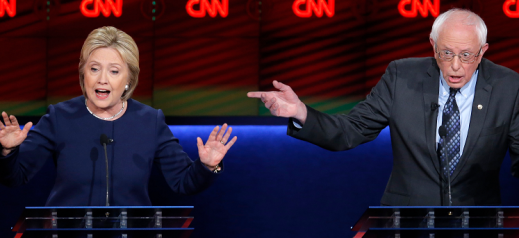
When Bernie Sanders launched his campaign on CSPAN he proclaimed:
Ask the people of Vermont, they will tell you, “Bernie Sanders has never run a negative ad.” I hate and detest these 30 second ugly negative ads.
Lately it’s hard to argue that Bernie has not gone more negative against Clinton, he often is caught bringing up her record, her Wall Street ties, speeches, and overall practices in a pejorative manner with increased frequency.
So what has changed? Certainly Bernie has stuck to his guns by not publishing televised attack ads but has began more and more spreading negative information about Clinton. From the days of “We don’t care about your damn emails” down to pressing Hillary to release her speeches something has clearly changed.
Lucky us, the political science research is rather explicit on this point: negative information works. Let’s break down a few ways this works after listing the scholars that comment on negative information.
Table 1. Negative Political Information Scholarship
|
Author (year) |
Description of Method and Key Findings |
| Garramone (1984) | Random telephone interviews of 211 mid-Michigan voters in 1982 congressional campaign found that older voters and voters that are more educated react contrary to the goals of a political attack advertisement. |
| Newhagen & Reeves (1988) | Surveyed respondents before and after negative ads were issued and found an impact in candidate recognition, but negative thoughts about the information which, when it wore off, would leave a positive result for the now recognizable candidate. |
| Marcus & Mackuen (1993) | Examined the American National Election Studies (ANES) panel of 1980 and a commercial survey during the 1988 presidential campaign. Found that one’s mood can influence their political emotions for particular candidates. |
| Skaperdas & Grofman (1995) | Game theoretic analysis of the strategies behind campaign tactics of using positive or negative information. Found that candidates rarely punch down and commonly punch up with negative information. |
| Iyengar & Ansolabehere (1995) | Through paid respondents qualitative and quantitative analysis, authors found that advertising is “not as egalitarian a form of campaign communication as expected” and that advertisements only reach better-informed candidates – thus shrinking and polarizing the electorate. |
| Freedman & Goldstein (1999) | Uses different measurements of respondent viewing behavior and ad tone to suggest that negative ads seem to invigorate someone to vote. |
| Redlawsk (2002) | Oftentimes voters, when subjected to negative advertisements, think through ways of why the advertisement is wrong. That is, the targets of negative adds often fail to be persuaded otherwise, but rather enforced by argument processing. |
| Brader (2005) | In an experimental analysis of respondents’ emotions, author found that ad images and music could evoke enthusiasm or vigilance in voters. |
| Taber & Lodge (2006) | Through experimental evaluation, participants showed both confirmation bias in their own beliefs on gun control and affirmative action whilst also showing disconfirmation bias when faced with information other than their own previously held beliefs. |
| Lau, Sigelman, Rovner (2007) | Using a meta-analytic reexamination of the relevant literature, Lau (et al.) confirms again that negative political information does not repress voter turnout. Even going so far as to say negative information increases campaign knowledge. |
| Martin (2008) | By using the 1974 National Election Study along with the Center for Political Studies’ content analysis of newspapers, author found that negative news could bring forth public political participation. |
| Redlawsk et al. (2010) | Reexamines past research to find when might someone reach the “tipping point” of their negative advertisement persuasion. Shows, through experimental methods, that no such tipping point exists. |
| Weinschenk & Panagopoulos (2014) | Examined a survey experiment (N= 724), authors found that those with the personality trait of extroversion were more likely to be motivated by negative messages whereas those with the personality trait of agreeableness were less likely when compared to their counterparts. |
As you see, most of negative political science literature supports what’s called the “stimulation hypothesis” (as opposed to the demobilization hypothesis) that negative political information drives action rather than depresses it. One example is Lau (et al.’s) 2007 meta analysis that found a strong favor for the stimulation hypothesis among political science data and research.
Oftentimes negative information is not used to convert the “other”to their side but rather to mobilize the already supporting electorate. So Bernie is using negative information to further mobilize his grassroots movement rather than using negative information to convert Clinton supporters (yet that wouldn’t hurt either).
Actually, very rarely do campaign advertisements change someone’s mind about their political candidate. If there is any doubt of this, just try and send Bernie campaign footage to a Donald Trump supporter – good luck.
So while Bernie may be using negative information to drive his own supporters and “stimulate” politics, how might his tactic of sticking to positive information in televised advertisements yield any utility?
Well, while the literature is lacking for positive political information (I suppose it’s not attractive enough for publication) , there is some literature to support positive information’s positive influence.
Table 2. Positive Information Scholarship
|
Author (year) |
Description of Method and Key Findings |
| Isen & Means (1983) | Subjects were asked to make a choice on several options of cars, those who received positive feedback about a prior task made decisions more quickly than those who had not received the positive feedback. |
| Maheswaran, & Meyers-Levy (1990) | Research in marketing found that “positively framed messages may be more persuasive when there is little emphasis on detailed processing, but negatively framed messages may be more persuasive when detailed processing is emphasized.” |
| Alvarez (1998) | Alvarez wrote a book on how the more a voter knows about a candidate, the more they are to support the “devil they know.” This exists even controlling for political differences and various other traits. |
| Ashby & Isen (1999) | Theory suggests that increased dopamine levels in the brain from positive affect may lead to creative problem solving among other positive side effects. |
| Fredrickson (2001) | Found that a “broaden-and-build” theory might be true, that positive emotions may “broaden momentary thought–action repertoires, which in turn serves to build their enduring personal resources, ranging from physical and intellectual resources to social and psychological resources.” |
| Fredrickson (2004) | Further research in psychology created distinctions between positive emotions versus moods. Here Fredrickson expands and solidifies the argument for the “broaden-and-build” theory of positive emotions. |
The scholarship on positive information found in many marketing journals (and health journals oddly enough) enforce the same results for different reasons. Positive information too drives political turnout often in the form of short-term boots of motivation and positive moods. Also, increasing the voter familiarity with the candidate helps humanize them and ultimately endorse them regardless of political ideology (Alvarez 1998).
In the end what can be taken away from this is that both positive and negative political information drive political turnout for different reasons including moods, knowledge, and strategy. Ultimately, any political information is good information to get your voice and message out to the public – no matter the vehicle.
So is it good that Bernie increased his negative political information output? Absolutely, negative messaging builds up a passionate electorate to ultimately turnout and vote – which we’ve seen in increased numbers since the start of Bernie’s campaign (thanks political science!)
I’ve written an essay that’s over 30 pages covering this topic in far more detail (that it deserves). Feel free to email me at MailKyleDavis@gmail.com for a final copy of the unpublished work. I hope to continue this topic in the future, adding more psychology research and ultimately analyze this topic at a neurological level.
On Voting Records: Nuance on Top of Nuance
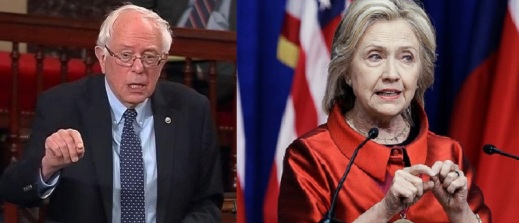
More and more voters have become concerned with Hillary Clinton’s record when compared to the seemingly perfect voting record of Bernie Sanders. Bernie Sanders in particular has referenced time-and-time again Clinton’s friendliness to Wall Street. If this wasn’t enough, the internet has become swarmed with video evidence of Hillary supporting seemingly staunch republican social programs at one time accepted under Bill Clinton.
One of the easiest methods of researching voting behavior is using the database at VoteSmart.org. You can search by issue for key bills elected officials vote on. Click here for Bernie Sanders’ voting record, and here for Hillary Clinton’s voting record. In the charts below I listed major policies both democratic nominees supported or fought but certainly did not read and report on every bill (nor did I even get close to covering every topic). Many of the links below will open a separate page where you can read more about the policies each candidate supported or fought against.
I think it’s important to not compare apples and oranges. Hillary Clinton has served as both the first lady of the United States and as the Senator of New York. For the purposes of comparing purely real political implications we will just cover the different stances both candidates have taken while in Congress.
There are three big topics that have been debated between the two candidates, Clinton’s reliability on LGBT rights, Bernie’s pacifism on foreign issues, and Clinton’s voting on economic issues – specifically campaign finance reform.
LGBT Rights
The internet has made it clear that Hillary Clinton has been shown making discriminatory claims about gay marriage for the state of New York before. Yet, her voting record has been far different for the most part.
Both the Defense of Marriage Act (DOMA) and Don’t Ask Don’t Tell were supported under President Bill Clinton, and endorsed by Hillary Clinton. Later on Bill Clinton would be honest in his mistake supporting those bills.

Yet, Bernie voted against both DOMA and Don’t Ask Don’t Tell. In comparison, Hillary turned around and voted pro LGBT on three major bills two of which supported marriage rights and one on including sexual identity discrimination as a hate crime.
The key difference between Bernie Sanders and Hillary Clinton is that Bernie has a longer record supporting gay rights, and has more experience legislating for gay rights. Many of Sanders fights have been during Bill Clinton’s time in office when “gays in the military” was a more topical debate.
Bernie Sanders has a record of supporting gay rights in many bills requiring the Department of Defense to report on the status of LGBT military members, provide equal treatment for them, and allow them to be open on their sexuality while serving.
Adding to this, Bernie Sanders has been very fair-handed with religion in the United States, always ruling in favor of separation but not infringement upon religion. Hillary Clinton has no major votes on the topic of religion, on science however both candidates have supported scientific progression (both having strong support for stem cell research) – Bernie in all of these areas has a far larger track record of support.
Military/Foreign Issues
Military issues is another area that Clinton has received flak for. Hillary has not denied that fact that she supported the Iraq war, whereas Bernie has been proud to have not have supported it.
Clinton has relatively little little legislative experience (7 votes) compared to Bernie Sanders (over 50 major issues).This doesn’t mean that Bernie is “more liberal” or has
voted “better” than Clinton it just means that he has had more experience.
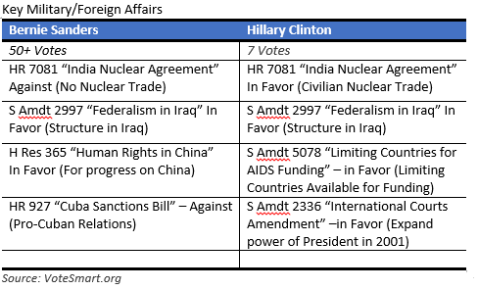
From the seven key pieces of legislation Clinton has reported on, she has shown herself diplomatic: in one case voting in favor of a civilian and military nuclear agreement with India. Bernie has the same record but with far more examples of diplomacy. Bernie has supported Cuban relations, China trade relations, limited operations in Yugoslavia, and even repairing the Bosnian crisis. Yet, interestingly enough, Bernie did not support the same bill Hillary supported on nuclear matters in India – likely because of the trade of nuclear technology (regardless of civilian usage or not).
So is Bernie more of a pacifist than Hillary? While Bernie is certainly more “dovish” he has rejected cries of pacifism since the first Democrat Party debate.
Economy
Clinton has frequently been accused of supporting big banks, resisting hard campaign finance reform, and being soft on social programs. Yet, in many of these areas there is more nuance before she began running for president.
Unfortunately we don’t know much about Clinton’s record with big banks from her time in the Senate. Given her softness on the issue during the presidential debate (the infamous 9-11 line) on topics like Wall Street endorsements and “too big to fail banks” we could only speculate how strongly she would oppose corporate America.
On campaign finance reform things become even more nuanced. She has voted in favor of many reforms on how interest groups donate to campaigns and how that information becomes publicly accessible. In 2001 she even co-sponsored a bill that would require broadcasting companies to require their lowest rate for political advertisements and the bill would raise the cap for small campaign contributions.
Finally, on social programs, Clinton voted to keep the “death”/estate tax on millionaires, and reinforce many social programs. Yet, as is the theme here, Sanders has voted on far more issues and has contributed more votes on programs like SNAP (food stamps) and even women’s rights (he voted in favor of four different paycheck fairness acts).
Overall
In a recent democratic debate Hillary Clinton said the following responding to Anderson Cooper’s question “will you say anything to get elected?”
I have been very consistent over the course of my entire life. I have always fought for the same values and principles. – HRC
Based upon this answer to the longevity of her ideology her statement is not true. Yet, if we look at Clinton’s senate voting record compared it to Senator Sanders there are some differences at the margins. Mainly, three takeaways can be found:
- Bernie Sanders has stood longer on principles than Clinton, and has more experience fighting for a variety of causes unlike Clinton.
- There is some nuance because Clinton does have plenty of positive votes on many key issues including campaign financing issues.
- In some areas Clinton is unclear or fails to support liberal principles (immigration).
There is a dichotomy that is present. It ultimately comes down to this: either you value experience and the long track record of supporting important issues (Sanders) or you don’t mind candidates changing their minds and having less to go on involving major issues of the day (Clinton). Given Sanders impressive ability to fight for today’s causes years ago, it’s hard to see how you could not applaud the man.
Super Tuesday: The Gist.
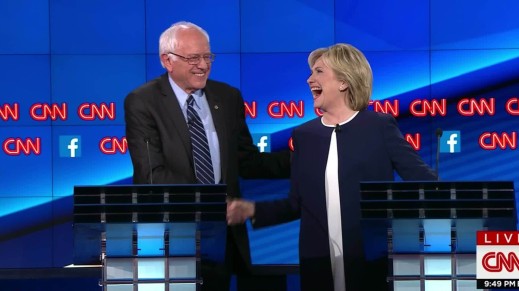
Miss the alleged “Super Tuesday?” Well here is the gist:
Donald Trump continued to win, if you want to see why or who to blame for his continued victories I’ve wrote about that topic elsewhere.
As for the democratic battleground between Sanders and Clinton, Bernie Sanders did surprisingly well. Polls before Super Tuesday ended up, on more cases than one, being wrong.
Here are the Google Super Tuesday results for the Democratic Party as of 12am 3/2/2016:
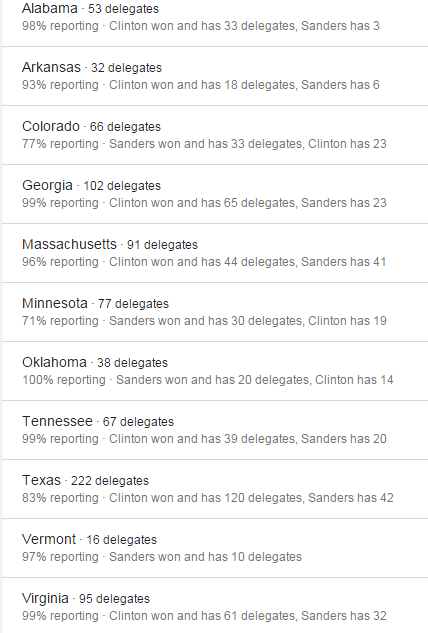
According to these updated delegate count here is the total for both candidates moving forward:
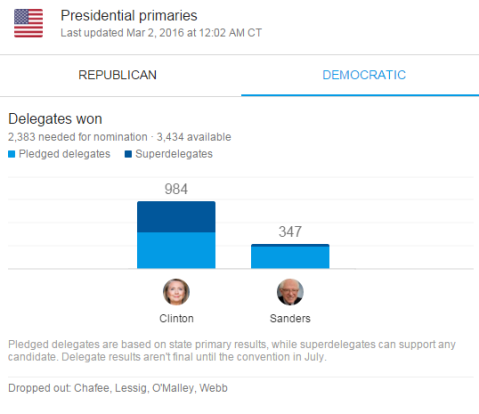
Note here that these Google results are slightly misleading. Superdelegates can still change their votes at anytime. In any case, it’s still a close race due to the states Bernie won:

Needless to say, there are still may states to come. Looking towards the future Clinton can expect more of a struggle as she runs out of states with large minority populations and more projected youth voter turnout which has been pro-Bernie to surprising accuracy.
As we have seen with Super Tuesday the polls are not always reliable as political strategists try and predict the results of the race between Bernie and Hillary. For example, in June, California will be a winner-takes-all primary for 172 delegates. We should look towards a multi-variate analysis of the states in the future as apposed to solely relying on polling data.
Overall, there is much to look forward to as a Bernie supporter, Bernie was able to beat the polls and win some key states in 2016’s “Super Tuesday.”